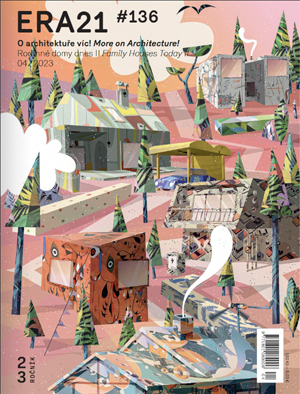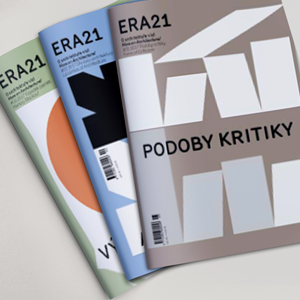| motto |
On Railways and their Essential Importance in Europe » entire article |
|
| news | ||
| reviews | ||
| detail |
Elementary School in Líbeznice » This new building completes in an urban planning fashion the existing complex of the elementary school on the north-east edge of Líbeznice that consists of the main school building from 1956 and an after-school club. The building was originally intended for a kindergarten; the proposed ring marked a circular garden for preschool kids within the school garden. Due to financial reasons and the demographical development of the village, the task was later changed to that of an elementary school. The building maintains the original concept of a house surrounding the outside environment. The core of the disposition is formed by an eccentrically located atrium that serves as an outdoor classroom, encircled by a multifunctional foyer integrating communications, locker rooms, and common spaces. On its perimeter there are eight classrooms, teachers’ offices, sanitary facilities, and a cafeteria that can be easily transformed into an auditorium for lectures, music or theatre performances. |
|
| intro |
The Overview Effect » From our earthly perspective, we are not able to see the whole complexity, broadness and impact of changes that man generates on the Earth. We can’t see them in their integrity and we are not able to perceive the broadest context. “The overview effect” has been described by astronauts as a phenomenon that can only be seen looking from space to the Earth. Only on satellite photos do these changes stand out—whether it is an intervention in the landscape or changes in urban structures. During the two centuries of its existence, the railway has become such an integral part of urban organisms that as urban inhabitants we perceive it as invariable and we often don’t realize the size of areas occupied by the railway system in the cities. Only from a superterrestrial perspective can one see furrows, craters, and structures of stations, tracks and depots, and their seriousness in the context of city urbanism and other human building production. |
|
| research |
New Cities on Rails » The current renaissance of railway transport and the rediscovery of urbanity as a positive quality intersect in the growing popularity of new urban districts, being realized together with the transformation of important railway stations in many European metropolises. Challenges these projects are facing can be seen by three ongoing “cities on rails”—Zurich, Utrecht and Stuttgart. |
|
| interview |
The Key to Success Was a Simple Plan. Andreas Schwab Interviewed by Filip Landa and Zuzana Morávková » With 109 hectares in size and an investment of over 4 billion Euro, the new Vienna Central Station is currently the biggest infrastructural project in Europe. About the process of planning and construction, financing, factors of success as well as potential complications we have discussed with Andreas Schwab, an expert on the project of Wien Hauptbahnhof from the City of Vienna. |
|
| completed project |
145 000: Vienna Central Station » The new Vienna station Wien Hauptbahnhof, situated on the southern border of the center, was built on the cleared sites of two former no-longer-suitable terminal stations—Südbahnhof and Ostbahnhof (South and East). Its centre consists of the station building with an integrated shopping center followed by an administrative district—Quartier Belvedere. The next phase includes building of residential houses—Sonnwendviertel. The area is completed with a large park and necessary public facilities. Constructing of a through station enabled the city to interconnect all directions in one place and strenghten the position of Vienna as an important junction for regional, national, as well as international transport. |
|
| cause |
Brno Has a Problem » Move it or leave it? That is the question Brno representatives have been trying to answer for almost a hundred years. The main station is still on the original location from 1839 along the inner city ring road and its capacity and technical condition haven’t met modern requirements for a long time. Why is it so difficult to solve this situation for good? Will the current city administration be able to take the radical historic step? |
|
| analysis |
Four Prague Stations » It’s been 170 years since the first train arrived to Prague and during that time railway transportation has become an inseparable part of the City. Some of the Prague stations’ extensive sites are losing their relevance, though, and becoming a desired commodity. Czech Railways have taken certain steps that seem quite unfortunate from a long-term perspective; developers are afoot. But the City still lacks a strategy how to deal with these urbanistically valuable areas. What is the past, present, and future of four Prague railway brownfields? |
|
| completed project |
110 000: Rotterdam Central » Rotterdam Centraal is one of the most important transport hubs in the Netherlands with a capacity of 110 000 passengers per day which is the same amount as in Schiphol Airport in Amsterdam. The original building designed by Sybold van Ravesteyn in 1957 was no longer suitable for such a large number of passengers and the growing complexity of the transport hub. The competition for the new building was issued in 2003 and as a result Team CS was formed from three different architectural studios. |
|
| completed project |
271 139: Transformation of King’s Cross Central Area in London » The railway hub King’s Cross Central has been developing on the northern outskirts of London since the 1850’s. Terminal stations for two railway companies developed here as well as a freight station that was gradually ailing until the former industrial area became a dead zone. Today, this notorious part of London is being transformed into a new district with various uses. |
|
| completed project |
Multifunctional Complex Barcode in Oslo » In 2003, there was an urban planning competition for the solution of one part of the Bjørvika waterfront in Oslo. The area of a former cargo port lined with a fjord was separated from the city in the past because of a railway and a high-speed road. Now it is being transformed into a new cultural district initiated by the new Opera building. The Barcode complex is being developed nearby and its architects had to deal with an immediate barrier of the central railway station tracks and solve the problem of how to connect the newly developed site to the urban structure. |
|
| strategy |
Railway 21: Opportunities, Needs, Perspectives » Railway transport is a frequently discussed topic within the European transport policy. A significant development of passenger as well as cargo transportation all over the European Union is expected in the future. That requires large investments in the modernization of railway systems and related infrastructures which is clearly reflected in the planning of our cities. |
|
| project |
Variable Railway Area » A diploma project composed at the Faculty of Architecture of TU in Brno under the supervision of Jan Mléčka is dealing with the possible uses of old and abandoned railway tracks, and their transformation respecting the current social needs. For that railway technology is used, being modified into various structures and adapted to local peculiarities of particular unused areas. |
|
| idea |
Sightseeing Tour » The main railway station in Brno and the space in front of the station building are places that confront a great number of people living, commuting or visiting the city. For a long time theres been an unsolved question—to move or to reconstruct—a question that has completely erased the option of changing this place within people’s thoughts. The Sightseeing Tour is an experience trip / a site-specific performance / a summer camp game / a municipal theatre that tries to mediate a different experience of the place for the viewers-participants so that they can understand the station area in a context they have never noticed before. The aim of the project is to draw attention to the current condition of the building and its neighborhood and to join the discussion about the possibilities of the station and to help to promote the area before the referendum scheduled in autumn 2016. |
|
| trends | ||
| annex |
Sanitary Technology—The Unconventional Arrangement of Sanitary Systems » The development in the field of sanitation follows the spirit of sustainable visions (“cities of the future”, “circular economy”) which means recycling resources as close to the place of their use as possible. One of the options how to meet these visions is the recycling of used water and heat. The easiest and most economical is to recycle greywater into the so-called whitewater. This way one can save up to 50 % of drinking water with return on investment in ten years. The technologies used for recycling greywater are proven, undemanding, and they can be automated and remote-controlled. Another investment connected with greywater may be oriented towards the reuse of heat from this water for the purpose of water heating. |
|
| annex |
Plasters and Plaster Systems from the Perspective of Correct Proposal » In many cases, plasters represent the final surface finish in existing buildings whether historical or newly built. The basic requirements ensure required appearance of buildings and protection of buildings for a maximum period of time. The important parameter is thus plaster lifespan that is affected by a technically correct design and a proper execution. This article maps technical parameters of most frequently used plasters, basic requirements of contemporary standards and their use for the suitable design. |
|
| annex |
Heating System Execution in Sustainable Buildings » The possibilities of use, functionality, reliability as well as the durability of systems arranging energy flows in the interior environment of buildings depend on the form and quality of their execution. What are the principles of their realization? |
|
| completed project |
Administrative Building Aviatica in Prague-Jinonice » Opened at the beginning of September, the administrative building Aviatica is the first realization of the planned development in an area of a former Walter Factory in Prague-Jinonice. A new urban structure connecting to the surrounding residential development is emerging on the 16.5 ha site. Approximately one third of the area in the southern part of the site is reserved for administrative buildings; in the quieter northern part there will be new residential development, and approx. one tenth of the site will be occupied by an urban park. |


ERA21 vydává ERA Média, s. r. o. |
|
|
Phone: +420 530 500 801 E-mail: redakce@era21.cz |
|
| WEBdesign Kangaroo group, a.s. |